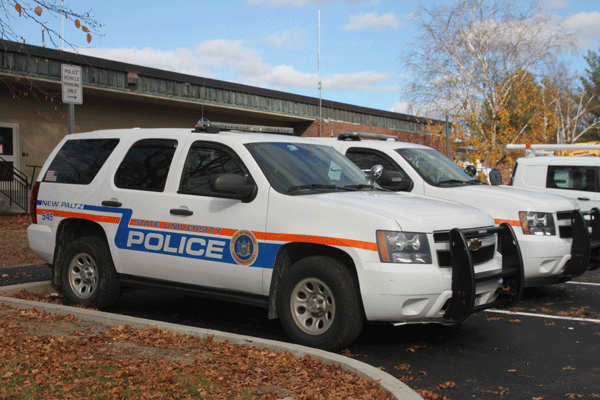
While students were home over winter break working, relaxing and catching up on sleep, SUNY New Paltz’s University Police Department (UPD) went to school to learn how to defuse an active shooter incident.
Joined by other local law enforcement, UPD occupied Esopus Hall on Jan. 7, 8, 10 and 11 for active shooter training that covered a wide array of situations officers may encounter.
“We try to do this training about once a year,” said UPD Chief David Dugatkin, adding that these days were planned about six months ago.
Most of the New Paltz Police Department (NPPD) and some officers from the Ulster County Sheriff’s Department (UCSD), New York State Troopers, Town of Lloyd Police Department and Town of Rosendale Police Department also participated. Certified instructors from UPD, NPPD and UCSD refreshed the officers on standard procedures and even taught a few new ones to keep officers ready to act if the time comes.
While this is not the first time UPD has hosted other departments for this training, January’s training did see the largest turnout from the most departments.
Dugatkin said the exercises varied from single-officer breaches of a room to larger group activities. During the training, the groups consisted of officers from multiple departments because in an actual event they would have to work together efficiently. Officers also used their standard issue firearms modified to shoot simunitions or small high-velocity paintballs ― this meant someone strapping on body armor and taking a few heavy hits.
“Scenario-based firearms training where we are not just shooting at a target is important because when it happens for real, a target is not what officers will encounter,” NPPD Lt. Rob Lucchesi said.
Esopus Hall was used because it was empty over the break, and UPD wanted to disturb as few people as possible. Dugatkin said it offered the right landscape with many rooms and narrow hallways. He said if an active shooter incident actually took place on campus, UPD will respond proactively to neutralize the shooter(s) as quickly as possible.
According to Lucchesi, while there are many, the initial procedures for an active shooter are universal. He said the geography of a location may call for situation specific adjustments.
“We are well-equipped to handle an on-campus active shooter incident,” Dugatkin said. “The college makes it a priority to ensure we have the equipment we need to protect everyone on campus; students, faculty and visitors.”
According to Dugatkin, there has not been an active shooter incident on the SUNY New Paltz campus in recent history. There have however been quite a few instances of on-campus active shooter incidents at public colleges in the past couple of years. In the last six months alone, Winston-Salem State University in North Carolina, Tennessee State University in Nashville, Northern Arizona University in Flagstaff, Umpqua Community College in Oregon, Sacramento City College in California and Savannah State University in Georgia all had an active shooter incident on campus that resulted in at least one death.
Dugatkin said that this training was routinely scheduled and not in response to these horrible events. The school also has an Emergency Response Plan posted on newpaltz.edu along with instructions on what to do if one is on campus during an active shooter incident.
